Category Archive 'Russian Attack on Ukraine'
27 Sep 2022

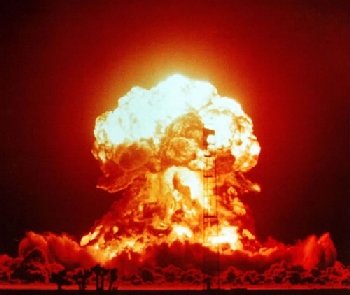
Quora asks:
Will Putin resort to nuclear weapons now that it is becoming increasingly clear, from the many, many posts that I have read on Quora, that he has little or no chance of being victorious in Ukraine by means of conventional war?
and John Mark McDonald dispels the bunkum.
As someone who has studied nuclear war for close to forty years now, I am going to give you an answer that will blow your mind. Even if the entire Russian nuclear arsenal were used against Ukraine, it wouldn’t substantially change the course of the war. How could I possibly say that? Because, the power of nuclear weapons has been used as a boogeyman for so long that the actual power of a nuclear detonation has almost no relation to their actual destructive power. No nuclear power can afford to actually use one in combat because it would expose the mythical nature of nuclear weapons.
Nuclear weapons are hyped to the point that no one contradicts it when a media outlet publishes a statement indicating that even a single nuclear device will destroy the world. This is a blatantly, stupidly, obviously untrue, but never corrected. After all, two were used in WWII. BUT that is just the tip of the iceburg. I thought there had been a couple of hundred nuclear test that prove this point. I was off by over an order of magnitude. There have been nearly THREE THOUSAND NUCLEAR DETONATIONS ALREADY, that are either known or suspected and this has not effected the survivability of life on Earth even slightly.
Well then, how dangerous are nuclear weapons? Nuclear weapons, if they weren’t their own catagory, would be classified as incendiary weapons. They set stuff on fire. They set a lot of stuff on fire. In fact they can set things on fire as far as two miles away from the actual detonation. Besides this, nuclear detonation are very bright, capable of blinding people 20–30 miles away. This is only constrained by the curvature of the earth. They also create hurricane force winds as the air around the detonation expands and contracts. If you are outside and unshielded and within a mile of a nuclear detonation, you are going to die.
The problem here is that Ukraine is really big. I mean the size of Texas big. Cities there tend to be spread out in modern times and their larger ones cover over a hundred square miles. The average nuclear detonation are only burn 2–3 square miles of territory. A city the size of Kiev would take on the order of 200 warheads to cover the whole thing.
Which brings us to our next point. Modern cities are just not that vulnerable to incendiaries. Modern city centers and industrial areas are made of concrete and steel. Most of the damage in Hiroshima and Nagasaki was done because almost all the buildings were made of wood and paper. The initial blast set the city centers on fire which spread and ended up burning down most of the city. Modern cities are just not that vulnerable. In Ukraine, despite millions of rounds of being poured into their cities, not one of them caught fire and burned to the ground like the Great Chicago or Great London Fires in the 19th century or the fire storms of WWII. In the Japanese nuclear detonations, the brick buildings were still standing, despite being much less sturdy than modern buildings. This leads to the most surprising revelation about nuclear detonations: If you are not outside, you stand a good chance of surviving even within the blast zone. Nuclear blasts are mainly line of sight killers. The vast majority of “radiation” created by an nuclear detonation is infrared radiation, or heat the same as a gas stove or fireplace makes. Unless the building you are in is collapsed by the wind or you fail to leave if it catches on fire or you happen to be in front of a window with a direct line of sight to the detonation, you are probably going to be fine.
Thus we get to the real reason why Putin will not use nuclear weapons: they’re just not all that effective compared to the boogeyman that is in our collective imaginations. Were a nuclear missile to detonate over central Kiev, no one would believe that it was an actual nuclear blast because the city is still there and all the major buildings are still standing.
Secondly, he doesn’t have very many of them. The numbers given for the Russian nuclear arsenal are an outright farce. You get that number by taking of bombs that the USSR claimed to have built, and subtract the number used in their testing program. This leaves you with about 9,000 warheads. First of all, Russia doesn’t have nearly enough delivery systems to put those warheads on. The second problem here is that nuclear warheads have a very short shelf life. Nuclear warheads require a detonator made of conventional expolsives. These detonators are some of the most precision pieces of engineering in the history of mankind. A series of explosives has to go off in such a way that the core is hit by the same amount of pressure from all directions simultaneously. If any of those explosives are even slightly off, the nuclear warhead will not go off. You now have an extremely precise machine sitting around a core of material emiting hard radiation. Hard radiation is not friendly to machines. Nuclear warheads need to be rebuilt a least every five years and maintained a lot more often than that. Even with that, a twenty year old warhead is a piece of junk. It’s been more than twenty years since the Putin kleptocracy came to power. I’m sure that Russia has a number of Potemkin warheads that are kept in top shape for inspectors, but given the current Russian system, the Russian nuclear arsenal most likely resembles the Russian tank reserves: the bare minimum kept in service while the rest is a scrap pile.
Currently, the spectre of the vast Russian nuclear arsenal is the last card he has in his hand. If he were to actually use it, it would expose that he never had anything but a junk hand and bluffing to back it up.
I can recall reading a scientific calculation that contended that if you took all the nuclear weapons in existence, put them into a great big pile and fired them off, you would not get a hole as large and deep as the Grand Canyon.
31 Jul 2022

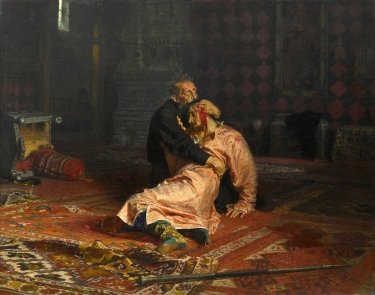
Ilya Repin, Ivan the Terrible and His Son Ivan on 16 November 1581
[Иван Грозный и сын его Иван 16 ноября 1581 года], 1883-1885, Tretyakov Gallery, Moscow.
There are very good reasons that neighboring countries are opposed to being governed by the political tradition of Muscovy, a political tradition consisting essentially of Despotism, Corruption, and Brutality.
John J. Mearsheimer, on June 16, gave a speech at the European Union Institute (EUI) on “The Causes and Consequences of the Ukraine Crisis.”
Professor Mearsheimer is a Russian apologist who blames the United States for “provoking” Russia into invading Ukraine. Mearsheimer’s sophistries have found an enthusiastic audience in the Nouveau-Paleocon Isolationist Buchananite wing of the Right.
Joe Ciricione offers a rebuttal of Mearsheimer.
In numerous essays and articles, Mearsheimer focuses his fire on U.S. and NATO policies for causing the Ukraine war and for its continuation. His speech, “Why Is Ukraine the West’s Fault?” has been viewed more than 27 million times. These views are echoed by many on the far left and the libertarian right, as well as the center. This makes it all the more vital to understand the gaps in his analysis that produce such a flawed result. His security equation is missing key variables.
The three most important are the security imperatives of Russia’s neighbors, the increasing authoritarianism of the Russian state and the true horror of Russia’s brutal war and occupation. By not adequately weighing these factors, Mearsheimer can explain Putin’s invasion of a peaceful, independent nation as a predictable reaction to Western provocations. He blasts the U.S. and NATO response as an overreaction to a limited conflict. Analyzing only parts of the equation, he arrives at a deeply flawed solution: In my understanding, he essentially calls on the West to militarily abandon Ukraine and to cede it to Russia’s sphere of influence.
Mearsheimer’s specific arguments are well known. (As one colleague told me, Mearsheimer’s writings are like Vivaldi’s concertos: beautiful, but they all sound alike.) He holds that “the United States is principally responsible for causing the Ukraine crisis.” That “Putin is not bent on conquering and absorbing Ukraine.” That the West has little to fear from Russia and only “began describing Putin as a dangerous leader with imperial ambitions” after the invasion and is doing so now only “to make sure he alone is blamed” for the war. He concludes that “the United States is not seriously interested in finding a diplomatic solution to the war,” bears primary responsibility for prolonging and escalating the war and is the principal obstacle to peace.
One can accept key points in Mearsheimer’s argument, as I do, without accepting his conclusions. NATO enlargement was problematic; I warned against it at the time and have criticized it more recently, preferring that the newly liberated states of Eastern Europe be brought into the European Union, not a military alliance created to counter the Soviet Union. Some U.S. policies have not taken into account legitimate Russian security concerns, particularly the deployment of missile interceptors in Poland and Romania that serve no useful purpose but, in Moscow’s view, do present a credible military threat, as I have long argued.
But NATO’s policies were not driven by “America’s obsession with bringing Ukraine into NATO and making it a Western bulwark on Russia’s border.” Rather—while some policymakers and experts have, indeed, proposed grander, hegemonic schemes, particularly during the run-up to and early years of the Iraq war—NATO policies since the end of the Cold War can largely be explained by the usual, mundane drivers: bureaucratic inertia and self-perpetuation; the politics of state-to-state relations; pursuit of new, profitable defense contracts; domestic politics; and the desire of U.S. and European politicians to demonstrate resolve, particularly against Iran.
The key driver of NATO expansion was one that I underestimated and that Mearsheimer specifically ignores: Eastern Europeans wanted protection from a historic foe. They pushed to join NATO; America did not pull them into an anti-Russian pact. Centuries of invasions instilled a genuine fear of Russia into their collective memories. Putin’s numerous nuclear threats since the beginning of the war remind all that however weakened Russia’s army may be by its battles in Ukraine, its nuclear weapons can destroy any nation it targets.
This is true of Sweden and Finland today. The U.S. is not manipulating them into joining a crusade to conquer Russia. These nations fear that Putin’s goals go far beyond those Mearsheimer describes. That is why they are abandoning decades (in Sweden’s case, three centuries) of neutrality. If they followed Mearsheimer’s logic, surely these countries would see that their national interests would be best served by assuaging Russia’s security concerns and continuing to remain free of military alliances. …
Mearsheimer’s assurances today that Putin has only “limited aims” and that his February blitzkrieg failed not because of fierce Ukrainian resistance but because the “Russian military did not attempt to conquer all of Ukraine” are as wrong now as they were in 2014. Then, too, he predicted that after seizing Crimea, Putin had no further territorial ambitions and even if he did he would be “unable to successfully occupy Ukraine.” He counseled that “Putin surely understands that trying to subdue Ukraine would be like swallowing a porcupine” and argued that Putin’s “response to events there has been defensive, not offensive.”
But Russia itself provides the rebuttal. In late July, Russian Foreign Minister Sergei Lavrov said outright that Moscow’s goal was to free Ukraine’s people from the “unacceptable regime” in Kyiv. He was following Putin’s lead. On June 9, Putin gave a speech on the war where he did not say one word about NATO or NATO enlargement but did wax eloquent about his similarity to Tsar Peter the Great, whose war with Sweden, he said, was justly “returning” land to Russia. “Clearly, it fell to our lot to return and reinforce as well,” he said. Hardly a defensive goal. Already, in occupied parts of Ukraine, Russian-backed administrators are introducing rubles as a new currency, handing out Russian passports, hoisting the Russian flag, taking over cell phone service and media and trying to re-educate teachers and children with new, pro-Russian versions of reality.
This focus on controlling the people and narratives in Ukraine hints at the second variable Mearsheimer ignores in his construct: Putin has long feared that popular resistance to his increasingly authoritarian rule at home would spread if Ukraine and other ex-Soviet republics grew too close to the West. Former Ambassador to Russia Michael McFaul pointed this out (correctly, in my view) when he faulted Mearsheimer in 2014 for not looking at the whole picture. “Russian foreign policy did not grow more aggressive in response to U.S. policies,” McFaul wrote. “It changed as a result of Russian internal political dynamics.
RTWT
Mearsheimer accepts the traditional insolent Muscovite claim of a supposed “right” to dominate and reduce to puppet state status unwilling neighbors. He additionally accepts the nonsensical argument that the “security” of Muscovy necessitates a wide cordon sanitaire of satellite regimes and imperial possessions. The obvious consideration that no aggressive European rival states exist and the United States and its allies make no claims or pretensions to ownership of any square foot of Russian soil.
The rivalry between America and Russia exists only to the extent of differing regime preferences concerning, and different client relationships with, a few Third World countries.
Unless Russia proceeds to start WWIII, nobody is going to raise a Grande Armée and march East.
But Russia has already flagrantly violated the implicit convention, that you do not attack other European states and you do not revise sovereign borders by force, that underlays the entire peaceful Post-WWII Order.
Russia is behaving today in the precise same vicious, aggressive, and mendacious manner that Germany and Japan did in the 1930s. Attempting to appease German aggression back then was a mistake and inevitably failed. We must either stand up to Russia now and stop the cycle of aggression and conquest before it goes any farther, or we will surely find ourselves not far down the road, unprepared and facing inevitable War.
03 Jul 2022

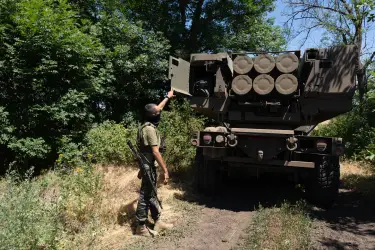
US-supplied HIMARS multiple rocket launcher.
Maybe, says Lawrence Freedman.
[T]he Russians are unlikely to keep on fighting should it become clear that they are likely to be defeated.
One lesson from the Snake Island episode, as well as the withdrawal from Kyiv, is that the Russian commanders can recognise when they are in a losing position and withdraw rather than take unnecessary punishment. Because we have been through a period of slow, grinding advances from Russia there is a tendency to assume that Ukraine will also have to overcome a tenacious Russian defence, that the third stage may look like the second, except with the roles reversed.
This is not as obvious as it may seem. Not only will Ukrainian tactics likely differ but, if they start being pushed back, the Russians will need to decide how much they really want to hold on to territory at the expense of preserving what is left of their army. If, at some point, the Russian command see only adverse trends ahead they may consider the long-term and the need to maintain their armed force to deal with future threats, other than Ukraine. Russia cannot afford an inch by inch retreat to the border, taking losses all the way. At some point they may need to cut their losses. This would be the point where they might urge Putin to engage in serious negotiations (for example reviving earlier proposals on a form of neutrality in return for full withdrawal) to provide political cover for their withdrawal.
Whether or not we get to this stage is a different matter. The challenge for Ukraine is to develop an offensive with some momentum to the point where there is no readily available way for it to be reversed by the Russians. This is a challenge because the Ukrainians will need to advance by means that do not solely involve direct assaults on Russians positions. Over the next few weeks we should start to get some sense of whether Ukraine can start to take the initiative and impose its own priorities on Russia rather than the other way round, and how well the Russians are able to respond to the steady improvement of Ukrainian capabilities. Should Ukrainian forces be able to create any momentum, however, then the situation could move in their favour very quickly. Can the Ukrainians win? Yes. Will the Ukrainians win? Not yet clear, but the possibility should not be dismissed.
RTWT
24 Jun 2022


The Royal United Services Institute (RUSI) warns that the US had better start rethinking the downsizing of its Defense Industries and Stockpiles.
The war in Ukraine has proven that the age of industrial warfare is still here. The massive consumption of equipment, vehicles and ammunition requires a large-scale industrial base for resupply – quantity still has a quality of its own. The mass scale combat has pitted 250,000 Ukrainian soldiers, together with 450,000 recently mobilised citizen soldiers against about 200,000 Russian and separatist troops. The effort to arm, feed and supply these armies is a monumental task. Ammunition resupply is particularly onerous. For Ukraine, compounding this task are Russian deep fires capabilities, which target Ukrainian military industry and transportation networks throughout the depth of the country. The Russian army has also suffered from Ukrainian cross-border attacks and acts of sabotage, but at a smaller scale. The rate of ammunition and equipment consumption in Ukraine can only be sustained by a large-scale industrial base.
This reality should be a concrete warning to Western countries, who have scaled down military industrial capacity and sacrificed scale and effectiveness for efficiency. This strategy relies on flawed assumptions about the future of war, and has been influenced by both the bureaucratic culture in Western governments and the legacy of low-intensity conflicts. Currently, the West may not have the industrial capacity to fight a large-scale war. If the US government is planning to once again become the arsenal of democracy, then the existing capabilities of the US military-industrial base and the core assumptions that have driven its development need to be re-examined. Read the rest of this entry »
11 Jun 2022


Deceased Russian Spetznaz sniper.
Philip Wasielewski at the Foreign Policy Research Institute looks at where things are after 100 days, and discusses future probabilities.
The Russian military is expending thousands of lives in Donbas to make incremental, almost World War I–style, advances over terrain that has no real strategic value. Russia is fighting a war of attrition. In the past, Russia and the Soviet Union had the manpower to make this an effective strategy. However, Russia today no longer has the mechanisms to recruit, train, equip, officer, and deploy substantial new military formations.
In early April, I estimated Russia had suffered approximately 10,000 soldiers killed in action (KIA) and a total of 35,000–38,000 casualties. It is still hard to estimate losses, but if Russian killed-in-action figures are now, per British intelligence estimates, roughly 15,000, then total casualties by early June could be approximately 50,000 men.
Who will replace them? The 130,000 Russian conscripts called up on April 1, 2022, are not supposed to go to a war zone (but many will). Putin, probably fearing social unrest, passed up the opportunity on Victory Day on May 9 to declare war and announce a general mobilization of Russian manpower.
Without a general mobilization, how can the Russian army meet wartime requirements and replace its losses? As word of horrible combat conditions reaches the population, recruiting of contract soldiers will suffer. It probably already has, based on the extreme decision to allow up to 50-year-old men to volunteer. Many contract soldiers are already announcing their intention to leave the army or refuse to serve in the “special military operation” that Moscow claims is not a war. Increased conscription cannot make up for recruiting shortfalls in a country where evading military service is practically a national sport.
If enough soldiers are found, who will lead them? Even before the war, Russia was having a difficult time retaining junior officers. In this war, officers of all levels have borne an extraordinary brunt of casualties. Many officer cadets have graduated early to participate in the war. Furthermore, who will train the new soldiers? Basic and advanced training in Russia’s army is done at the individual unit level, but many training officers and noncommissioned officers have already deployed with their units to Ukraine. This leaves limited cadres at home to instruct new conscripts. Metaphorically speaking, the Russian army is eating its seed corn.
If enough enlisted men and junior officers can be found to serve as replacements for the tens of thousands of casualties, can Russia equip them with modern weapons? Equipment losses are catastrophic. The Oryx website, using conservative, thoroughly documented confirmation techniques, estimates that as of the end of May 2022, Russia had lost 741 tanks, 1,342 armored/infantry fighting vehicles, and 27 fixed-wing combat aircraft. Actual losses are likely higher.
Besides these losses, vehicles, airplanes, and helicopters involved in three months of nonstop fighting require major refitting, which is unlikely to happen while combat operations are underway. War can exhaust machines as well as men, and without proper maintenance, existing hardware will become incapable of supporting operations. New replacements for destroyed equipment will not be coming. Russia’s main tank factories have shut down due to sanctions, which have also hobbled its aircraft industry. T-62 tanks have been pulled out of reserve, but half-century-old tanks are no answer to modern anti-tank weapons.[24] Decades of munitions production have been used up in three months, and the decline in the use of guided and cruise missiles indicates that precision-guided weapons are in short supply.
Ukraine is also facing serious military difficulties. It has not concentrated enough forces in Donbas to match Russia’s current quantitative edge, and it too is suffering high casualties. The previous article in early April estimated that Ukraine had suffered approximately 3,100 killed in action and 16,000–18,000 casualties of all types. On April 16, President Zelensky announced that Ukraine had suffered between 2,500 and 3,000 killed in action and an additional 10,000 wounded. Extrapolating from these figures to the present, Ukrainian military KIA figures could be approaching 6,000 men and approximately 25,000 total casualties due to the high intensity of the battles of the Donbas and Mariupol. Per Oryx, Ukraine has lost 186 tanks, 276 armored/infantry fighting vehicles, and 22 fixed-wing combat aircraft, but these again are conservative figures. Attrition warfare is cutting both ways. The winner may be the side that lasts just a moment longer than the other.
There are strategic differences between Russian and Ukrainian losses. Ukraine is in a better position to replenish its losses of men and materiel. It can afford to trade some territory for time to assimilate Western supplies. With incoming weapons from the West and the training of new volunteers, the Ukrainian army will grow in numbers and capabilities, while the Russian army is unlikely to. When ready, Ukraine will have the forces to counterattack. The Croatian army did the same after losing territory in 1992 to Serbian forces. By 1995, with Western tutoring and supplies, Croatia had rebuilt its army and counterattacked, forcing the Serbs out of the Krajina region within a week. Ukraine could play a similar “long game.”
RTWT
22 May 2022

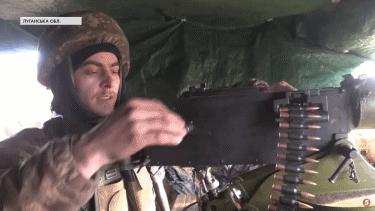
Ukrainian soldier with Maxim Gun.
Jillaire Belloc observed complacently: “Whatever happens, we have got The Maxim Gun, and they have not.”
And apparently the Russians are sending conscripts into combat armed with Mosin-Nagant rifles.
SOFREP:
The Russian invasion of Ukraine has brought about the resurgence of some of both countries’ old weapons that still pack a good punch, some of which have outlived their operational capacity. However, there are a few that still does make a difference despite their age, and one of those weapons is the M1910 Maxim machine gun.
Footage and photographs of the M1910 Maxim machine gun had surfaced on social media after it made its 2022 debut on the battlefield. However, they have been seen being used by the Ukrainian Armed Forces in 2018 as well to hold fortified positions, notably by the 92nd Mechanized Infantry Brigade.
Using old weapons has been not uncommon during this three-month-old war as both countries have, one way or another, used very old weapons to arm their troops. The Russian forces are guilty of arming their conscripts with Mosin-Nagant rifles from the 1800s, and they were also allegedly spotted using a very old antique cannon to guard a checkpoint in Kherson. The Mosin-Nagant rifles are very much still capable of blasting the heads of your enemies off, and it is still a reliable weapon to wield. Nevertheless, the Maxim is still a pretty good machine gun. It is water-cooled and has a rate of fire of 600 rounds per minute, and fires the 7.62×54 round. This round is still in use today in the Dragunov, SV-98 sniper rifle and the PKM machine gun. It is a bit bulky to lug around and is usually serviced by a crew of 4-6 soldiers to drag it on it wheeled carriage, and carry ammo and water for it.
M1910 Maxim machine guns used by Ukrainian forces in Luhansk, 2020 (Rob Lee). Source: https://twitter.com/RALee85/status/1223317491365163008
M1910 Maxim machine guns used by Ukrainian forces in Luhansk, 2020 (Rob Lee/Twitter)
The same can be said for the Ukrainian forces, who are now using the M1910 Maxim machine gun. Yup, there are loads of other better options out there, but we think it’s more acceptable for Ukraine’s situation as the country needs all the weapons it can get to fend off Russian invading forces. For the Russians, we think that for a country that boasts their so-called military prowess, they could have armed their conscripts with something better than Mosin-Nagant rifles. It’s funny to think that the Russians have actually mocked the Ukrainians for using this machine gun, telling their public that the Ukrainians lack modern weapons when they themselves have been using olden munitions too.
But going back to the M1910 Maxim machine gun, we’d argue that they are still very much effective given the way they are used under certain conditions. To give you context, this machine gun entered service in 1910 and was in service during World War I during the Russian Empire (not even the Soviet Union yet), so this weapon is likely older than your granddad. Older versions of this weapon were in Imperial Russia’s arsenal as early as 1891. You can usually find it mounted on a two-wheeler with an armored gun shield.
The Ukrainians have been using it to defend fixed and fortified positions, so no worries about moving it around. They could move it, but these are 150 pounds per unit, so it does take a bit of effort to carry, but then again, it is wheeled so they could tow the weapon. In comparison, the M2 .50 cal weighs some 121 pounds, a weapon that is also used by the Ukrainians. These M1910s use 7.62mm x 54mm ammunition and can fire 600 rounds per minute. They’re also water-cooled, enabling the user to fire for an extended period of time when compared to the Russian PKM, which is prone to overheating and a cook-off even when just fired for over a minute. However, the PKM does have a higher fire rate and is much lighter.
RTWT
22 May 2022

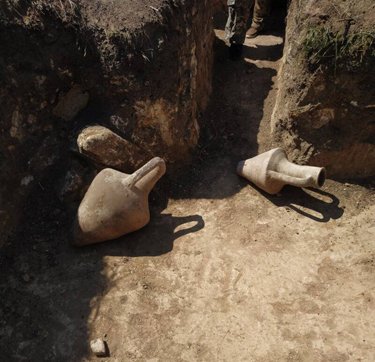
While digging trenches in Odessa, soldiers from the 126th Territorial Defense discovered Greek jars, which date to the earliest days of the city’s history 2,500 years ago and which once most likely held wine or grains.
ATI:
As Russia’s invasion of Ukraine has decimated cities and turned millions of people into refugees, Ukrainian defense forces in the city of Odesa have been busy building trenches for a future attack. And they just made a stunning find in the process — a trove of ancient Greek urns buried just under the surface.
According to Smithsonian Magazine, soldiers of the 126th Territorial Defense unearthed these amphorae earlier this month. The unexpected find of elongated bottle-neck jars was accompanied by several ceramic shards. The surprised brigade publicized the discovery in a Facebook post on May 12.
While the discovery of intact jars in impeccable condition was fascinating on its own, their origins revealed an even more staggering history. The amphorae have been dated to the fourth or fifth century B.C.E., about 100 years after the first Greek settlement was constructed in the area that would eventually become Odesa.
Astonishingly, the jars survived millennia of warfare and invasions — only to emerge in the midst of a modern conflict.
According to Artnet, the 126th brigade safely transported the artifacts to the Odesa Archaeological Museum. Not even the imperative construction of military fortifications against Russian soldiers impeded Ukrainians from safeguarding these relics. For local onlookers, that distinction spoke volumes.
“Ukrainian soldiers dug trenches and found ancient amphorae,” said journalist Yana Suporovska, according to Heritage Daily. “They have already been transferred to the museum. We are not Russians; we preserve our history.”
RTWT
Your are browsing
the Archives of Never Yet Melted in the 'Russian Attack on Ukraine' Category.
/div>

Feeds
|





 203mm self-propelled gun 2S7 Pion, which had reportedly destroyed the bridge between Sievierodonetsk & Lysychansk today
203mm self-propelled gun 2S7 Pion, which had reportedly destroyed the bridge between Sievierodonetsk & Lysychansk today




